Continuing the series of posts showing work taken in London in 1979 as posted to Facebook with comments an image at a time in the first half of 2018.
Previous post in London 1979 series
______________________________________________________
London Photographs 1979 – Peter Marshall
This set of pictures is a little unusual in that they are all in portrait format and I think I must have set myself a small challenge. Almost all cameras (except those that use a square format) have always been designed so that the natural way to use them is in landscape format. Of course it isn’t hard to turn a camera through 90 degrees, but it can foten be rather tricky to find a good way to hold it steady and release the shutter smoothly.
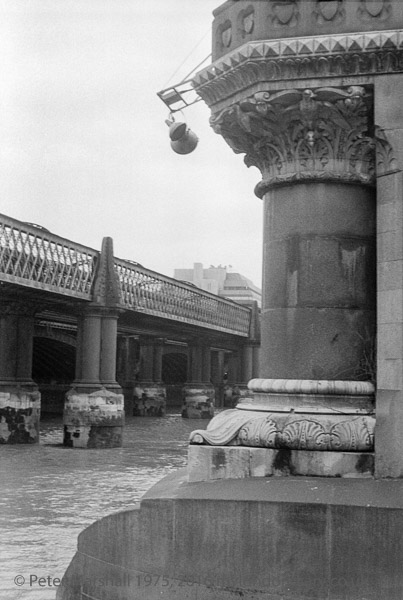
Blackfriars Railway Bridges and pier Blackfriars Bridge, City, 1979
19j-24: river thames, pier, bridge, railway,
There were then still two rail bridges at Blackriars, with the nearer one at left being the Alexandra Railway Bridge built by engineer Joseph Cubitt (1811-1872) for the London, Chatham & Dover Railway around 1864. The river piers were groups of three cast-iron cylinders clad in stone and filled with concrete and some can still be seen, but the track and bridge girders on top of them were removed in 1985. The bridge led from the original Blackfriars Bridge station on the south bank to Ludgate Hill station which was closed in 1929. The track continued north on a bridge across Ludgate Hill which was removed in 1990 and replaced at a lower level by a tunnel leading into City Thameslink station.
Blackfriars Railway Bridge, also known as St Paul’s Bridge was completed in 1886 to lead to St Paul’s station, now known as Blackfriars. It is still in use and now has an impressive array of solar panels on top of it. There is now an entrance on the south bank too.
Although the Alexandra bridge pillars remain, not all are visible. They were in sets of three, one on each side and one in the centre of the bridge. Only the upstream two of each triplet remain visible with the third encased in a new concrete coating and used to support a widened Blackfriars rail bridge.
The pillar at right is of the Blackfriars Road Bridge, another built to a design by Joseph Cubitt. Opened in 1869 it replaced an earlier bridge of 1769, the third bridge across the Thames, after London Bridge and Westminster Bridge. To enable navigation the three Blackfirars bridges were required to be built with their piers aligned. The piers carry stone carvings by by sculptor John Birnie Philip showing birds, with those on the seaward side here showing marine life and seabirds.
Blackfriars Bridge was often said to be the point where the freshwater Thames met the saline tidal river, though of course the river is tidal for some miles further upstream – now to Teddington lock, though without this the tides would flow further.
But in earlier years the tide was restricted by the narrow arches of the old London Bridge, and before there was any real human intervention and the Thames spread more widely probably only travelled as far as Vauxhall.
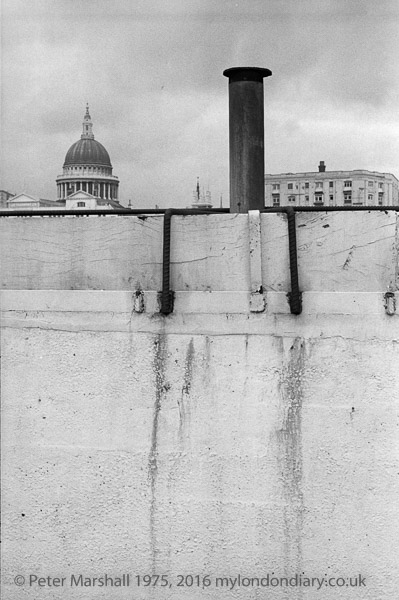
St Paul’s Cathedral from Bankside, Southwark, 1979
19j-42: wall, church,
This wall was on Bankside, but and was a temporary flood defence, before the Thames Barrier was completed in 1982. These temporary barriers were later replaced by permanent ones which are I think rather less high.
One of the sillier pages on the BBC web site tries to answer the question ‘Why was the Thames Barrier built’ with the answer “In 1953 a very bad flood covered 160,000 acres on Canvey Island and killed 300 people in Essex. That forced the UK government to appoint a committee to look at flooding. The solution was the Thames Barrier, built at a place called Woolwich Reach.”
Which was not in any way going to help Canvey Island, miles further downstream, but has so far done a good job in preventing flooding upstream of Woolwich.
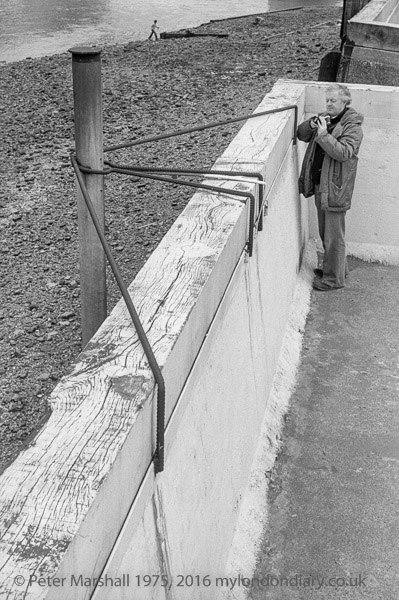
Temporary river wall, Bankside, Southwark, 1979
19j-43: river thames, foreshore, wall, Randall Webb, photographer
Another view of the wall makes clear that it was a flood barrier, as well as showing the late Randall Web, once a friend of mine, struggling with his camera. We were both members of something called Group 6, a small group of photographers from the Richmond and Twickenham Photographic Society who came to an evening meeting once a week to talk photography and arranged monthly outings on Sundays to take photographs – on one of which these pictures were taken. In 1982 we arranged our first group exhibition, later breaking away from the RTPS as Framework and producing a number of shows.
Randall myself and Terry King had been sitting together in a row in a meeting of the Richmond & Twickenham Photographic Society when an elderly former advertising photographer. a Mr Steinbock from Maidenhead delivered a lecture, showing us one of the small prints (“little gems”) that he had for many years exhibited in the annual Royal Photographic Society shows.
Though I didn’t much care for the picture, the idea of making non-silver prints like his gum bichromates intrigued us all as he described in some detail how he made them. I was teaching chemistry, and the store where I worked had an embarrassingly large stock of potassium dichromate, and I liberated a couple of surplus jars, one for my own experiments and the other as a gift to Terry.
Terry went on to became one of the best-known people in alternative processes, making prints, running workshops and organising conferences, while around 20 years later Randall Webb was co-author with Martin Reed of ‘Spirits of Salts: A Working Guide to Old Photographic Processes’.
I made one or two gum prints, and rather more with other alternative processes – cyanotype, kallitype, platinum, salted paper and more – before deciding that I was rather more interested in photography than alternative printmaking.
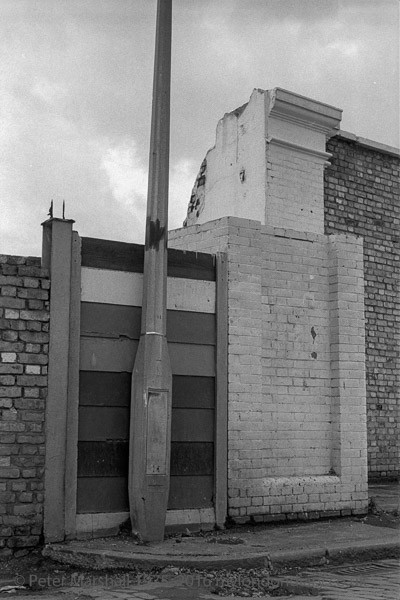
Wall, Bankside, Southwark,1979
19j-45: wall,
I can’t recall what the substantial wall at the right had been built around, but by this time it was a derelict site. The horizontal planks filling a doorway were I think highly coloured and probably around the site on which the modern reconstruction of the Globe, named “Shakespeare’s Globe”, opened in 1997, thanks largely to the efforts of Sam Wanamaker and the Shakespeare Globe Trust he founded.
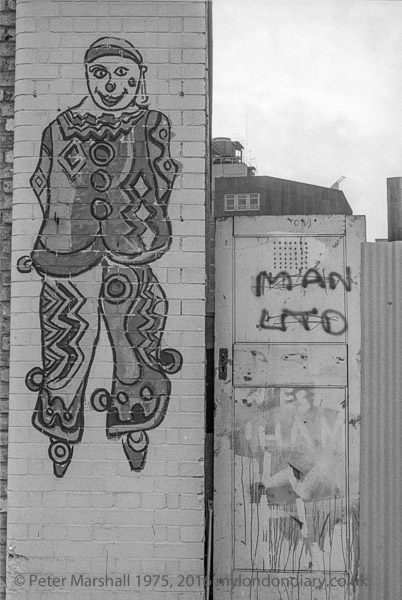
Clown on Wall, Bankside, Southwark,1979
19j-46: wall, drawing, graffiti
Another wall close to the future site of the replica of Shakespeare’ Globe Theatre, with a picture of a clown. There was also another theatre in the area.

Lee Brothers, Borough Market, Southwark,1979
19j-62: railway arch, potato merchant, market
Although this sign has apparently been photographed and put on the web by every living photographer or tourist strolling through Borough Market with a phone or digital camera, not one of the links on Google gives any more information about Lee Brothers. Although the sign is still there they are not to be found in the list of traders, which moves from L’Ubriaco Drunk Cheese to Le Marché du Quartier without them.
I can add very little. Lee Brothers (Borough Market) Limited was only incorporated as a private limited company with share capital in 1987, some years after I made this picture and it is now dissolved. The stall below their sign in Bedale St has for some years been part of the fruit and veg wholesaler and retailer ‘Turnips’ run by Fred and Caroline Foster.
At the time I was probably more interested in the shaft of sunlight and the shadow on the road. I made two virtually identical frames with the same slight lean to the right, which suggests it was deliberate, though I can’t see why

Park St, Southwark,1979
19j-65: granary, store, warehouse, bridge,
15 Park St is next to the railway bridge.
There are faint residues of text about the right hand door, two lines which appear to end ..N.’ but I can make out nothing more. Later it read ‘Perot Export[ateur]’ which I suspect was probably added above the low door for a film made using this building. There are also faint traces of text at the right of this door, where later was the text, attributed to Banksy, ‘This is not a photo opportunity’, now also long gone, probably worn off my the number of times it was photographed. I think I resisted the opportunity.
Slightly more legible when I took this picture in 1979 was the ‘ghost image’ above the window at left which reads
‘KRA…..
GRANARIES‘
but I can’t tell you how the upper word, presumably a name, ends.
The building has appeared in a number of films but is probably best known from the hilarious film ‘Lock, Stock and Two Smoking Barrels‘ (1998) which centred around it. By then it had been considerably renovated.
______________________________________________________
More to follow shortly
Continuing the series of posts showing work taken in London in 1979 as posted to Facebook with comments an image at a time in the first half of 2018.
Previous post in London 1979 series
______________________________________________________
The pictures in this series of posts are exactly those on London Photographs, where landscape format images display slightly larger. Clicking on any picture will go to the page with it on the web site.
I have included the file number and some keywords in the captions; you can order a print of any picture on this site using the file number.
Order details and prices
______________________________________________________
There are no adverts on this site and it receives no sponsorship, and I like to keep it that way. But it does take a considerable amount of my time and thought, and if you enjoy reading it, a small donation – perhaps the cost of a beer – would be appreciated.
My London Diary : London Photos : Hull : River Lea/Lee Valley : London’s Industrial Heritage
All photographs on this and my other sites, unless otherwise stated, are taken by and copyright of Peter Marshall, and are available for reproduction or can be bought as prints.
To order prints or reproduce images
________________________________________________________